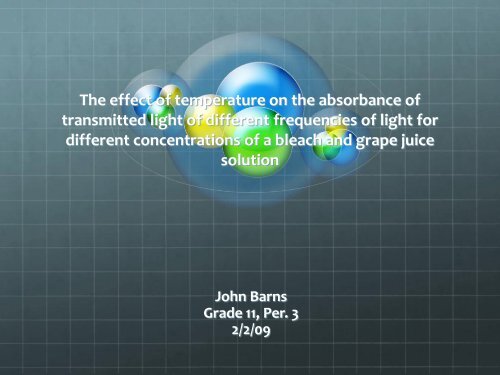The effect of temperature on the absorbance of ... - Woodbridge High
The effect of temperature on the absorbance of ... - Woodbridge High
The effect of temperature on the absorbance of ... - Woodbridge High
You also want an ePaper? Increase the reach of your titles
YUMPU automatically turns print PDFs into web optimized ePapers that Google loves.
<str<strong>on</strong>g>The</str<strong>on</strong>g> <str<strong>on</strong>g>effect</str<strong>on</strong>g> <str<strong>on</strong>g>of</str<strong>on</strong>g> <str<strong>on</strong>g>temperature</str<strong>on</strong>g> <strong>on</strong> <strong>the</strong> <strong>absorbance</strong> <str<strong>on</strong>g>of</str<strong>on</strong>g><br />
transmitted light <str<strong>on</strong>g>of</str<strong>on</strong>g> different frequencies <str<strong>on</strong>g>of</str<strong>on</strong>g> light for<br />
different c<strong>on</strong>centrati<strong>on</strong>s <str<strong>on</strong>g>of</str<strong>on</strong>g> a bleach and grape juice<br />
soluti<strong>on</strong><br />
John Barns<br />
Grade 11, Per. 3<br />
2/2/09
Purpose/ Hypo<strong>the</strong>sis<br />
Purpose<br />
<str<strong>on</strong>g>The</str<strong>on</strong>g> purpose <str<strong>on</strong>g>of</str<strong>on</strong>g> this experiment was to determine if<br />
<str<strong>on</strong>g>temperature</str<strong>on</strong>g> would affect <strong>the</strong> <strong>absorbance</strong> <str<strong>on</strong>g>of</str<strong>on</strong>g> transmitted <str<strong>on</strong>g>of</str<strong>on</strong>g><br />
light for different c<strong>on</strong>centrati<strong>on</strong>s <str<strong>on</strong>g>of</str<strong>on</strong>g> a bleach- grape juice<br />
soluti<strong>on</strong>.<br />
Hypo<strong>the</strong>sis<br />
It is believed that <strong>the</strong> highest <str<strong>on</strong>g>temperature</str<strong>on</strong>g> <strong>on</strong> <strong>the</strong> lowest<br />
c<strong>on</strong>centrati<strong>on</strong> <str<strong>on</strong>g>of</str<strong>on</strong>g> <strong>the</strong> soluti<strong>on</strong> will decrease <strong>the</strong> amount <str<strong>on</strong>g>of</str<strong>on</strong>g><br />
absorbed light for <strong>the</strong> soluti<strong>on</strong> <strong>the</strong> greatest and that <strong>the</strong><br />
lowest <str<strong>on</strong>g>temperature</str<strong>on</strong>g> <strong>on</strong> <strong>the</strong> highest c<strong>on</strong>centrati<strong>on</strong> will<br />
increase <strong>the</strong> amount <str<strong>on</strong>g>of</str<strong>on</strong>g> absorbed <strong>the</strong> greatest amount.
Background Research<br />
<str<strong>on</strong>g>The</str<strong>on</strong>g> process <str<strong>on</strong>g>of</str<strong>on</strong>g> bleaching can occur in <strong>on</strong>e <str<strong>on</strong>g>of</str<strong>on</strong>g> two<br />
ways.<br />
1. Ei<strong>the</strong>r <strong>the</strong> bleach can oxidize <strong>the</strong> substance, breaking<br />
<strong>the</strong> chemical b<strong>on</strong>ds that make up <strong>the</strong> molecules in a<br />
substance that generate <strong>the</strong> color.<br />
2. it can change <strong>the</strong> double b<strong>on</strong>ds <str<strong>on</strong>g>of</str<strong>on</strong>g> a molecule that<br />
produces a color into single b<strong>on</strong>ds, changing its<br />
ability to absorb light.<br />
<str<strong>on</strong>g>The</str<strong>on</strong>g> molecule in most soluti<strong>on</strong>s that produces <strong>the</strong><br />
visible color is called a chromophore.
Background Research<br />
(c<strong>on</strong>t.)<br />
<str<strong>on</strong>g>The</str<strong>on</strong>g> additi<strong>on</strong> <str<strong>on</strong>g>of</str<strong>on</strong>g> bleach into a soluti<strong>on</strong> or its<br />
applicati<strong>on</strong> to a surface such as clothing, which<br />
c<strong>on</strong>tains dyes, will change <strong>the</strong> ability <str<strong>on</strong>g>of</str<strong>on</strong>g> <strong>the</strong> dye to<br />
absorb any transmitted light <str<strong>on</strong>g>of</str<strong>on</strong>g> similar wavelengths.<br />
When <strong>the</strong> ability <str<strong>on</strong>g>of</str<strong>on</strong>g> a dye or chromophore to<br />
transmit or absorb a certain color is changed, <strong>the</strong><br />
result is an overall fading <str<strong>on</strong>g>of</str<strong>on</strong>g> <strong>the</strong> originally dominant<br />
color.<br />
Bleach is used because it breaks <strong>the</strong> chromophore<br />
b<strong>on</strong>ds and shifts <strong>the</strong> color to white, which is a basic<br />
palate for o<strong>the</strong>r colors.
Background<br />
Research (c<strong>on</strong>t.)<br />
Portable Colorimeter<br />
Beer’s Law states that <strong>the</strong><br />
original <strong>absorbance</strong> <str<strong>on</strong>g>of</str<strong>on</strong>g><br />
light by a soluti<strong>on</strong> is<br />
directly proporti<strong>on</strong>al to <strong>the</strong><br />
c<strong>on</strong>centrati<strong>on</strong> <str<strong>on</strong>g>of</str<strong>on</strong>g> <strong>the</strong> liquid.<br />
Beer’s Law is represented<br />
by <strong>the</strong> equati<strong>on</strong>;<br />
I=I0x10^(-kcl)<br />
To measure <strong>the</strong><br />
<strong>absorbance</strong> <str<strong>on</strong>g>of</str<strong>on</strong>g> light, a<br />
colorimeter is needed.<br />
A colorimeter uses a<br />
photometer to measure<br />
<strong>the</strong> amount <str<strong>on</strong>g>of</str<strong>on</strong>g> light that<br />
passes through a soluti<strong>on</strong><br />
and how much <str<strong>on</strong>g>of</str<strong>on</strong>g> that light<br />
is absorbed by <strong>the</strong> soluti<strong>on</strong><br />
itself.
Methods/ Materials<br />
<str<strong>on</strong>g>The</str<strong>on</strong>g> manipulated variable was <strong>the</strong> <str<strong>on</strong>g>temperature</str<strong>on</strong>g> <str<strong>on</strong>g>of</str<strong>on</strong>g> <strong>the</strong> bleach<br />
soluti<strong>on</strong>.<br />
<str<strong>on</strong>g>The</str<strong>on</strong>g> resp<strong>on</strong>ding variable was <strong>the</strong> percent <str<strong>on</strong>g>of</str<strong>on</strong>g> transmitted light<br />
that was absorbed by <strong>the</strong> soluti<strong>on</strong>.<br />
C<strong>on</strong>trols:<br />
<strong>the</strong> c<strong>on</strong>centrati<strong>on</strong> <str<strong>on</strong>g>of</str<strong>on</strong>g> <strong>the</strong> bleach soluti<strong>on</strong><br />
<strong>the</strong> frequency <str<strong>on</strong>g>of</str<strong>on</strong>g> light being used to record <strong>the</strong> <strong>absorbance</strong> <str<strong>on</strong>g>of</str<strong>on</strong>g><br />
transmitted light<br />
<strong>the</strong> <strong>absorbance</strong> <str<strong>on</strong>g>of</str<strong>on</strong>g> <strong>the</strong> 100% grape juice and 100% bleach<br />
<strong>the</strong> type <str<strong>on</strong>g>of</str<strong>on</strong>g> bleach used<br />
<strong>the</strong> grape juice used<br />
<strong>the</strong> amount <str<strong>on</strong>g>of</str<strong>on</strong>g> soluti<strong>on</strong> in each vial used for data collecti<strong>on</strong>
Methods (c<strong>on</strong>t.)<br />
A colorimeter was used to quantify <strong>the</strong> amount <str<strong>on</strong>g>of</str<strong>on</strong>g><br />
light that was absorbed by each soluti<strong>on</strong><br />
To determine what <strong>the</strong> affect <str<strong>on</strong>g>of</str<strong>on</strong>g> <str<strong>on</strong>g>temperature</str<strong>on</strong>g> was <strong>on</strong><br />
different c<strong>on</strong>centrati<strong>on</strong>s, 5 different c<strong>on</strong>centrati<strong>on</strong>s<br />
<str<strong>on</strong>g>of</str<strong>on</strong>g> bleach were mixed with grape juice, a comm<strong>on</strong><br />
staining agent<br />
<str<strong>on</strong>g>The</str<strong>on</strong>g> amount <str<strong>on</strong>g>of</str<strong>on</strong>g> absorbed light for each <str<strong>on</strong>g>of</str<strong>on</strong>g> <strong>the</strong>se<br />
samples was recorded and <strong>the</strong>n trials were<br />
c<strong>on</strong>ducted that involved varying <strong>the</strong> <str<strong>on</strong>g>temperature</str<strong>on</strong>g>s <str<strong>on</strong>g>of</str<strong>on</strong>g><br />
each sample
Methods (c<strong>on</strong>t.)<br />
In order to change <strong>the</strong> <str<strong>on</strong>g>temperature</str<strong>on</strong>g> in a c<strong>on</strong>sistent<br />
ratio for each sample, all 5 samples were immersed in<br />
both a hot water bath and a cold water bath, with <strong>the</strong><br />
average <str<strong>on</strong>g>temperature</str<strong>on</strong>g> <str<strong>on</strong>g>of</str<strong>on</strong>g> <strong>the</strong> water being measured<br />
accurately by an electr<strong>on</strong>ic <strong>the</strong>rmometer which<br />
tested <strong>the</strong> <str<strong>on</strong>g>temperature</str<strong>on</strong>g> every 4 sec<strong>on</strong>ds<br />
<str<strong>on</strong>g>The</str<strong>on</strong>g> results were recorded for each percent soluti<strong>on</strong><br />
and at each <str<strong>on</strong>g>temperature</str<strong>on</strong>g>
Results<br />
•<str<strong>on</strong>g>The</str<strong>on</strong>g> overall trend in data<br />
shows that <strong>the</strong>re is an inverse<br />
relati<strong>on</strong>ship between <strong>the</strong><br />
<str<strong>on</strong>g>temperature</str<strong>on</strong>g> <str<strong>on</strong>g>of</str<strong>on</strong>g> a soluti<strong>on</strong> and<br />
<strong>the</strong> amount <str<strong>on</strong>g>of</str<strong>on</strong>g> light that it<br />
absorbs<br />
•Figure 1 is a sample <str<strong>on</strong>g>of</str<strong>on</strong>g> data,<br />
dem<strong>on</strong>strating <strong>the</strong> overall<br />
trend <str<strong>on</strong>g>of</str<strong>on</strong>g> <strong>the</strong> amount <str<strong>on</strong>g>of</str<strong>on</strong>g><br />
absorbed light<br />
C<strong>on</strong>centrati<strong>on</strong>-<br />
25%<br />
Temperature<br />
%<br />
Transm<br />
ittance<br />
%<br />
Absorbance<br />
2.64 14.90 -0.76<br />
red 18.34 16.50 -0.80<br />
32.53 19.10 -0.95<br />
2.64 6.80 0.01<br />
Green 18.43 6.60 0.11<br />
32.53 8.30 -0.10<br />
2.64 0.60 0.60<br />
Blue 18.34 0.60 0.60<br />
32.53 0.70 0.70<br />
2.64 11.10 11.10<br />
Orange 18.34 10.90 10.90<br />
Figure 1
Discussi<strong>on</strong>/ Analysis<br />
<str<strong>on</strong>g>The</str<strong>on</strong>g> original hypo<strong>the</strong>sis is supported by <strong>the</strong> data.<br />
<str<strong>on</strong>g>The</str<strong>on</strong>g> amount <str<strong>on</strong>g>of</str<strong>on</strong>g> red light that was absorbed by <strong>the</strong><br />
grape juice was most affected by <strong>the</strong> change in<br />
<str<strong>on</strong>g>temperature</str<strong>on</strong>g><br />
If <strong>the</strong> experiment had been tried with a different<br />
colored soluti<strong>on</strong> with <strong>the</strong> bleach <strong>the</strong> affect that<br />
<str<strong>on</strong>g>temperature</str<strong>on</strong>g> would have had <strong>on</strong> <strong>the</strong> <strong>absorbance</strong> <str<strong>on</strong>g>of</str<strong>on</strong>g><br />
o<strong>the</strong>r wavelengths may have been altered.
Discussi<strong>on</strong> (c<strong>on</strong>t.)<br />
<str<strong>on</strong>g>The</str<strong>on</strong>g> overall <str<strong>on</strong>g>effect</str<strong>on</strong>g> <str<strong>on</strong>g>of</str<strong>on</strong>g> <str<strong>on</strong>g>temperature</str<strong>on</strong>g> <strong>on</strong> <strong>absorbance</strong> <str<strong>on</strong>g>of</str<strong>on</strong>g><br />
transmittance <str<strong>on</strong>g>of</str<strong>on</strong>g> light is very small however, as <strong>the</strong>re is<br />
not a large visible difference in <strong>the</strong> visible color <str<strong>on</strong>g>of</str<strong>on</strong>g> <strong>the</strong><br />
soluti<strong>on</strong>.<br />
<str<strong>on</strong>g>The</str<strong>on</strong>g> experiment may have been much more c<strong>on</strong>trolled if a<br />
single wavelength <str<strong>on</strong>g>of</str<strong>on</strong>g> light had been focused <strong>on</strong> or if <strong>the</strong>re<br />
had been multiple trials c<strong>on</strong>ducted for each set <str<strong>on</strong>g>of</str<strong>on</strong>g> data<br />
<str<strong>on</strong>g>The</str<strong>on</strong>g> data seems to show that bleach becomes more<br />
<str<strong>on</strong>g>effect</str<strong>on</strong>g>ive as <strong>the</strong> <str<strong>on</strong>g>temperature</str<strong>on</strong>g> <str<strong>on</strong>g>of</str<strong>on</strong>g> <strong>the</strong> soluti<strong>on</strong> is raised, as<br />
this allows <strong>the</strong> overall <strong>absorbance</strong> <str<strong>on</strong>g>of</str<strong>on</strong>g> light to be decreased<br />
by <strong>the</strong> largest amount for a staining agent.
C<strong>on</strong>clusi<strong>on</strong><br />
<str<strong>on</strong>g>The</str<strong>on</strong>g> original purpose <str<strong>on</strong>g>of</str<strong>on</strong>g> this experiment was to determine<br />
if bleach would become more <str<strong>on</strong>g>effect</str<strong>on</strong>g>ive as a stain remover<br />
as <strong>the</strong> <str<strong>on</strong>g>temperature</str<strong>on</strong>g> <str<strong>on</strong>g>of</str<strong>on</strong>g> a soluti<strong>on</strong> was increased<br />
<str<strong>on</strong>g>The</str<strong>on</strong>g> data collected supports that <strong>the</strong> warmer a soluti<strong>on</strong> <str<strong>on</strong>g>of</str<strong>on</strong>g><br />
bleach, <strong>the</strong> more <str<strong>on</strong>g>effect</str<strong>on</strong>g>ive it is in accomplishing its goal <str<strong>on</strong>g>of</str<strong>on</strong>g><br />
decreasing <strong>the</strong> overall <strong>absorbance</strong> <str<strong>on</strong>g>of</str<strong>on</strong>g> <strong>the</strong> original<br />
wavelengths <str<strong>on</strong>g>of</str<strong>on</strong>g> light for a soluti<strong>on</strong>.<br />
By using a colorimeter, <strong>the</strong> results can be viewed as being<br />
appropriately accurate
Future Research/<br />
Applicati<strong>on</strong>s<br />
In <strong>the</strong> future it may be more helpful to use a wider<br />
variety <str<strong>on</strong>g>of</str<strong>on</strong>g> soluti<strong>on</strong>s and wavelengths <str<strong>on</strong>g>of</str<strong>on</strong>g> light<br />
<str<strong>on</strong>g>The</str<strong>on</strong>g> <str<strong>on</strong>g>temperature</str<strong>on</strong>g> <str<strong>on</strong>g>of</str<strong>on</strong>g> <strong>the</strong> soluti<strong>on</strong>s may be more<br />
closely c<strong>on</strong>trolled in <strong>the</strong> future<br />
This can be applied when dealing with cleaning<br />
clothing or o<strong>the</strong>r stained materials with bleach
Literature Sources<br />
D.M. Co<strong>on</strong>s. “Bleach: Facts, Fantasy, and Fundamentals”<br />
Jan. 1978. J.AM. Oil Chemist’s SOC. (Vol. 55) July 2007<br />
http://www.springerlink.com/c<strong>on</strong>tent/y181204t1t643964/<br />
Chemistry Teaching at <strong>the</strong> University <str<strong>on</strong>g>of</str<strong>on</strong>g> Cambridge 10<br />
Sept. 2008 http://wwwteach.ch.cam.ac.uk/teach/IA/KCR_full.pdf<br />
Caprette, David R. “Principles <str<strong>on</strong>g>of</str<strong>on</strong>g> Spectrophotometry.<br />
“Experimental Biosciences. 16 Sept. 96. Rice University. 25<br />
Sept. 2008<br />
http://www.ruf.rice.edu/~bioslabs/methods/protein/spectr<br />
ophotometer.html
Acknowledgments<br />
I would like to thank my dad for providing <strong>the</strong><br />
equipment for measuring <strong>the</strong> <str<strong>on</strong>g>temperature</str<strong>on</strong>g> precisely<br />
and for providing a good work space<br />
I would also like to thank my teacher Mr. Antrim for<br />
providing <strong>the</strong> colorimeter and <strong>the</strong> overall idea for <strong>the</strong><br />
project




